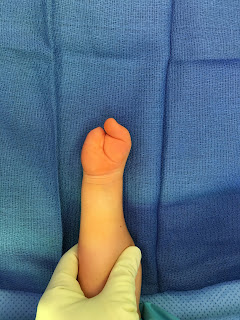I have written numerous times in this blog about the importance of improving function for kids born with hand differences. Function can be made better through therapy, through splinting, or through surgery. Whenever possible, we want to improve appearance as well. There have been several investigations that found that kids born with hand differences are typically well adjusted, found HERE, HERE, and in our investigation to be published soon. However, it is also clear that improving appearance is important to kids and families. In a perfect intervention, we would improve both function and appearance.
There may be a times, thankfully not often, when improving function may come at a cost of some worsening of appearance. If this is a possibility, frank discussions should be held with the family and many will eagerly proceed with an intervention for improved function.
This case is one example. The child has symbrachydactyly, the cleft type (classification is reviewed in this POST). He does well overall but has trouble grasping with the hand.
 |
| Symbrachydactyly, cleft type, palm view |
 |
| Symbrachydactyly, cleft type, top view |
 |
| Symbrachydactyly, cleft type, top view with thumb held |
The thumb is of reasonable quality but the pinky is not greatly developed. When we think of how to improve function in these situation, we need to lengthen the digits to allow the thumb and pinky the ability to pinch or grab. There are three basic options:
 |
| This is the same patient after cleft deepening. |
 |
| Palm view after cleft deepening. |
For this particular patient, the seemingly small amount of deepening will (and has) make a notable difference for function. And as he gets older, lengthening the bones can still be considered.